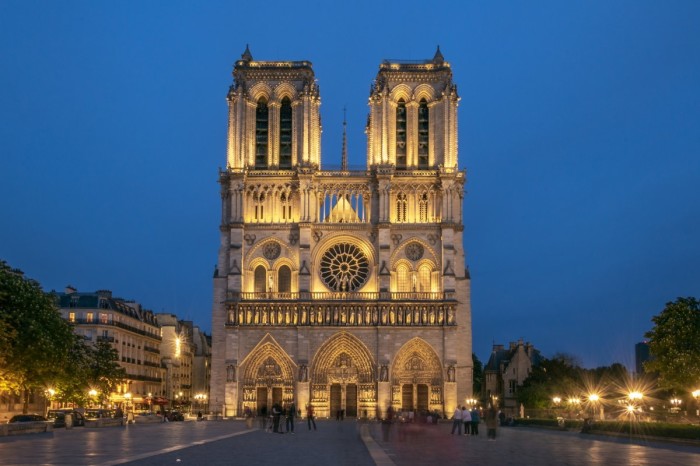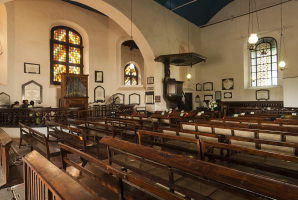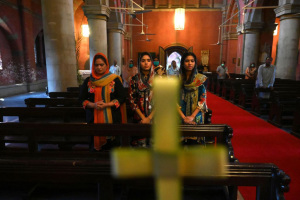The possible ‘distortion’ of a great cathedral

The great Medieval cathedrals of Europe were not only beautiful edifices but, more importantly, vast halls of learning through artistic narrative.
Rather than simply reading or merely hearing the message of the cathedrals, one could take them in classic art forms that still speak and show the Gospel story centuries later.
Chartres Cathedral, for example, was called “The Bible in Stone” because of the biblical messages revealed in sculpture, painting, and rock.
To change the forms and distort the visuals would be the equivalent of rebuilding Paris in a 1940s minimalist style had the Nazi Commander obeyed Hitler’s reputed orders to burn the city to the ground.
Paris was not burned in 1945, but one of its most famous landmarks burned in 2019. Proposals have been made that, according to the London Daily Mail, will turn the 7th-century Cathedral into a “woke theme Park.” New chapels, for example, will include one dedicated to the “environment.”
Critics of the revamping of the Notre Dame interior fear the re-designers will “distort” the historic edifice.[1] One hundred intellectuals, art critics, artists, and writers signed a statement criticizing the proposed renovation, claiming that it “completely distorts the decor and the liturgical space.”
Even French President Emmanuel Macron got into the act. He wanted to replace the flame-destroyed spire with “a contemporary architectural gesture.” One trembles to imagine what that might look like. Thankfully there was many objections from the public that Macron’s idea was scrapped.
Paris architect Maurice Culot says, according to the London Telegraph, that “it’s as if Disney were entering Notre Dame... What they are proposing to do to Notre Dame would never be done to Westminster Abbey or Saint Peter’s in Rome. It’s a kind of theme Park and very childish and trivial given the grandeur of the place.”
The power of the cathedral narrative was not trivial. It came home to me on an unforgettable afternoon in 1997. My wife and I were in England visiting with family. On a side trip to York, we walked through York Minster Abbey, a mighty Cathedral whose towers can be seen from afar.
However, on that day, it was the up-close that drew the attention of my seven-year-old granddaughter. She and I held hands and strolled slowly through the fascinating building, looking at inscriptions and art bedecking the ancient walls.
Suddenly the little girl pulled on my hand as she looked on a particular display — a crucifix.
“Paw-Paw, who’s that man on the cross?” she asked as she studied a graphic artwork mounted on the wall.
I led her to a nearby row of chairs. We sat under the vaulted roof and talked about the narrative of the cross. When we were through my granddaughter knew Who the Man on the cross was and why He was there on that cross.
It’s easy to understand the concerns of iconoclastic reformers who feared that fascination and focus on religious art could easily deteriorate into idolatry. But sometimes the reformers went too far, stripping the instructing and inspiring art from the churches that needed to be learning centers, a mission in which the art played a major role.
True, the narrative-through-depiction was important in the illiterate societies of the Middle Age, but there is much biblical illiteracy in our “advanced” age — the illiteracy of human souls that need to see deep truths in iconic form.
In the Reformation, Protestants might say that Catholics held on to too much, but Catholics might believe that Protestants lost too much. Iconoclastic reformers jettisoned the great art that carried such wonderful stories in stone and paint.
The outcomes in our time mean a near-idolatrous relationship with statues and pictures for some Catholics and a somewhat contemptuous view by radical iconoclasts of many non-Catholic denominations.
What has emerged in some contemporary churches is what could be called the “grunge church”: stubbled-faces, sloppy tattered jeans and shirts, and baseball hats worn during praise segments.
The aim to identify with modern folk is admirable. But this is often based on a wrong assumption that all moderns relate to grunge. Many find it demeaning of them and the message conveyed from the platform.
This style also constitutes a narrative, but not one that inspires a focus on God, High and Lifted Up, the Transcendent majesty of God.
Remember Paul’s exhortation in Philippians 4: Let all be done with excellence.
The “grunge church” distorts worship, replaces beauty with the boorish, and mars the sublime loveliness of the Gospel in the attempt to reach the spiritually illiterate.
May church buildings of all kinds — be they great cathedrals, stark urban-styled shells, or steepled rural houses of worship, understand and preserve the narrative described in their existence as physical structures.
May they display a Gospel that will not yield to the trends of a given era.
May they all be structures that show forth the beauty of the Lord in their worship and proclamation, and even in their physical appearance.
May they be a beautiful Gospel narrative in their very construction.
And, above all, may it be so clear that a little child is prompted to ask: “Who is that man on the cross?”
[1]artnet AG (via Public) / French Heritage Experts Have Approved Controversial Notre-Dame Plans That Critics Say Will ‘Distort’ the Famed Cathedral (publicnow.com)
Wallace Henley was born two days before the attack on Pearl Harbor on December 5, 1941. After serving as a White House aide during the Nixon administration, Henley went on to become an award-winning journalist for the Birmingham News in Alabama. He is the author of more than twenty books, including God and Churchill with Jonathan Sandys, Winston Churchill’s great-grandson. Henley has led leadership conferences around the globe. He has been married to his wife, Irene, for more than fifty years. They have two children, six grandchildren, and four great-grandchildren. His latest book, Two Men from Babylon: Nebuchadnezzar, Trump, and the Lord of History, is available wherever books are sold.





























